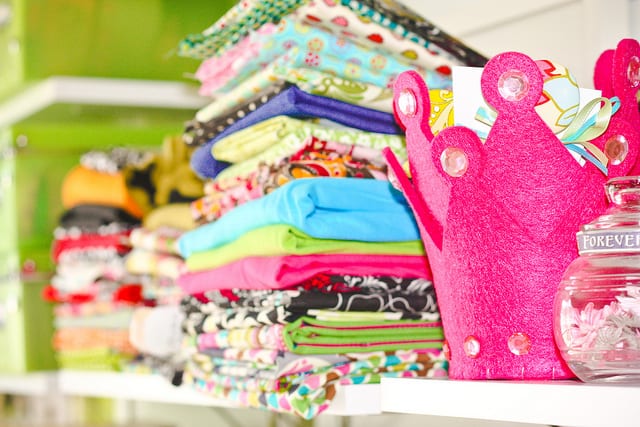This month, we’re focusing on our featured New Year’s resolution for 2016, learning to separate emotion from “stuff.” But we’re also self-aware enough to realize that some of the content in this section can end up sounding as though we think that you should throw away everything that you own and live in a treehouse with only the food and shelter that you need to survive. Just like we’re not judging you if you do decide to abandon society for a treehouse, we’re also not judging you if you want to maintain lots of “stuff” and even if you have an attachment to some “stuff.” We just want you to think critically about where that attachment comes from and whether it (or how much of it) is healthy for you. And we certainly don’t think that all “stuff” is created equally. In fact, we think that there’s a huge distinction between “stuff” that somebody made for you and “stuff” that somebody bought for you. Today we’ll be exploring why one of those categories always trumps the other in our minds. But no matter what your opinion on it may end up being, we’re not judging you for it!
Mom Always Said She’d Rather Have Something That You Made!
We’re going to take a stab in the dark and say that at least part of the reason that mom said the above was because a house with a kid is by default a house full of “stuff” and she was anxious to reduce the load. But the bigger part of why mom said this is that handmade gifts are full of meaning on multiple levels. There’s the obvious reason that you know that the person who made the gift for you put time and thought and effort into it. No matter what you say, a handmade gift trumps a last-minute run into Bath & Body Works every single time. And it’s nice to know that somebody cared enough to take the time to make you something. But we think that that’s a secondary reason why handmade gifts are more worthy of emotion.
Handmade gifts can truly capture a moment in time. When your child is little and makes you a drawing, that drawing does capture that moment in the child’s life. However, if dad takes that child to the store to buy mom new slippers, that’s just buying slippers. There’s no actual relationship between the “thing” and that year of the child’s life. To use an older-age example, if your teenager gives you what he or she made in woodshop (do schools even still have woodshop?) as a gift, that captures what that child was doing as a teenager. But that same teenager running to Target for a sweater could be that child thirty years later, still grabbing a sweater off of a rack at Target.
We truly do believe that it’s unhealthy to attach emotion to “stuff,” but handmade stuff walks a much finer line (if at all) than store bought “stuff.” And it’s not just because of what goes into the handmade items. It’s because of the anonymity of the store bought items.
Store Bought Items: By the Masses, For the Masses
We do have some standards about what we think must be necessary for emotion to be involved. We’ve discussed them previously this month in our articles about why “stuff” can’t love you back. You are of course entirely entitled to agree or disagree with our opinions on that matter. But we do think that emotion on a basic level requires something individualistic. Can you have emotion for a sweater if three million of exactly the same sweaters exist? We’d argue that you can’t. You might then say that twin people exist and emotions can be applied to them. And we’d argue back that while they may be physical twins, even identical twins have different personalities and different psychological and emotional makeups. They are not cloned inanimate products. A mass produced sweater is a cloned inanimate product. We’re going to simply argue that a person can’t feel emotion for something that simply is not unique. We know that we just had an entirely one-sided text-based debate with you, but we’d love to hear your side if you disagree. We have plenty of social media channels linked below just for that!
Regardless of the Source of the Item, Be Wary of Assigning Too Much Emotion to It
We’ll certainly concede, and obviously so far have dedicated about six hundred words to conceding, that we can understand a certain amount of emotion behind handmade items. In fact, we have some handmade items that we’re admittedly emotional about. But the core premise of this month’s topic remains true. It’s still only stuff. It isn’t a child, or a person, or an animal, or a plant, or a place or a time. It’s a thing. And while things can inspire you to remember emotions, they can’t actually create emotions. And they can’t feel emotions back for you. The danger point is when you start associating so much emotion with a thing that it takes away from your ability to focus on people and places where your emotions can be expressed healthily.
There’s also always the “spiral trap” to be aware of. Once you start assigning emotion to some things, you can easily start assigning emotions to other things!
Like anything, learning to understand that things can create the memory of emotion versus believing that there’s emotion attached to things can be a process. We actually think that understanding why some things (handmade ones) can have a more valid relationship to emotional reactions than other things (non-handmade ones) can be an important step in the process.
Now, get out there and make something for somebody you care about!
Disagree with our assessment? Tell us about it on the social media channels below.
Facebook | Twitter | Instagram | Tumblr | Pinterest | Google+ | Medium
Photo Credit: chrissy.farnan via Flickr





